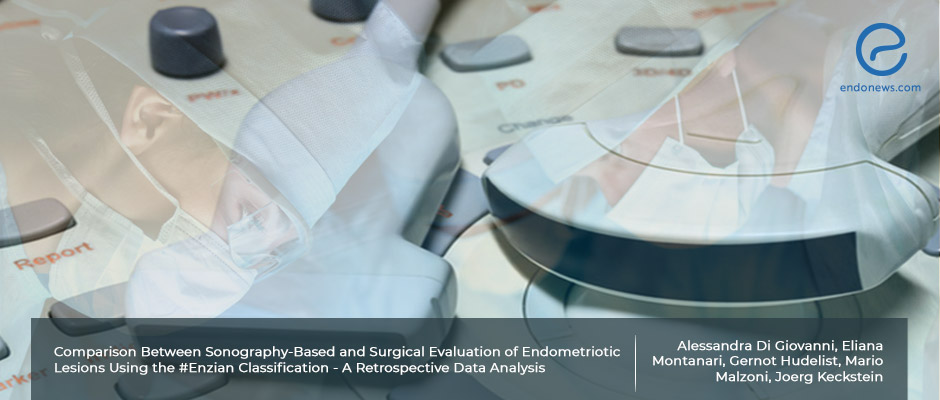Preoperative detailed ultrasound is effective for the prediction of surgical extent.
May 25, 2022
Transvaginal ultrasound matches with perioperative ENZIAN classification score
Key Points
Highlights:
- Preoperative transvaginal sonography predicts lesions and adhesions with high sensitivity and specificity.
Importance:
- The prediction of lesions and adhesions preoperatively provides proper preparation for surgical management of endometriosis disease. Thus, ultrasound imaging is important when it is done by experienced hands.
What's done here:
- 96 women who had preoperative transvaginal sonography and then had deep infiltrating endometriosis surgery in 2019 have been included.
- Patients with suspected malignancy or secondary cases like previous colorectal surgery, previous surgery for deep infiltrating endometriosis including vaginal resection, full-thickness bowel resection, or excision of the lesion involving the urinary bladder have been excluded.
- All surgery reports have been reanalyzed according to ENZIAN classification and all lesions have been described in mm size.
- The ENZIAN classification have been defined as follows: #Enzian A (vagina, retro cervical area, RVS),#Enzian B (USL, parametria), #Enzian C (rectum),#Enzian O (ovary),#Enzian T (tuba-ovarian condition),#Enzian FB (urinary bladder), #Enzian FU (ureters), #Enzian FI (other intestinal locations).
- #Enzian compartment P (peritoneal lesions) has not been evaluated, as it can only be assessed during surgery but not during ultrasound imaging.
- The percentages of concordance (with 95 % confidence intervals, and describing the false-positive rates as 5mm change) between TVS and surgery were calculated.
Key Results:
- The prediction of lesions on #Enzian compartment C (rectum) was with the highest rate of exact concordance with 74% of cases. It increased to 87% when the tolerance margin was taken up to 3 mm for sonography measurements.
- For compartment B (uterosacral ligaments, parametria) and compartment A (vagina, rectovaginal space), the rates of exact concordance were around 60% which has been explained by the authors as inappropriate measures of surgery when trying to resolve gathered lesions.
- In compartment T (tubo-ovarian unit), the most reliable estimations were seen for slight and severe adhesions).
- Sensitivity has been found to be almost 100% for all compartments except for A and B left (97%) and FB (urinary bladder, 86%)
- Also, specificity was 100% for FB, FI (other intestinal locations), FU (ureters), and O-right, 86-98% for A, B-right, C, O left, and FO (other extragenital lesions), and 70% for B left.
Limitations:
- The study has a retrospective nature and the ultrasonographer and surgeon are experienced specialists which affects the results.
- Also the surgeon had been aware of the TVS findings which might cause a study bias.
Lay Summary
Endometriosis surgery is like opening the box of pandora when you start the surgery. A preoperative guide is extremely important for the surgeon to draw a road map.
In the study conducted by Alessandra Di Giovanni et al, the effectiveness of preoperative advanced transvaginal sonography has been questioned as to be a preoperative lead for the surgeon by comparing with perioperative ENZIAN classification.
Ninety-six women who had preoperative transvaginal ultrasonography and then had deep infiltrating endometriosis surgeries during 2019 have been included in the study. Patients with suspected malignancy or secondary cases like previous colorectal surgery, previous surgery for deep endometriosis including vaginal resection, full-thickness bowel resection, or excision of a DE lesion involving the urinary bladder have been excluded. All surgery reports have been reread and analyzed according to ENZIAN classification and all lesions have been described in mm size.
The ENZIAN classification have been defined as follows: #Enzian A (vagina, retro cervical area, RVS), #Enzian B (USL, parametria), #Enzian C (rectum), #Enzian O (ovary), #Enzian T (tuba-ovarian condition), #Enzian FB (urinary bladder), #Enzian FU (ureters), #Enzian FI (other intestinal locations).#Enzian compartment P (peritoneal lesions) has not been evaluated, as it can only be assessed during surgery but not during ultrasound imaging.
The percentages of concordance (with 95 % confidence intervals, and the false-positive rates as 5mm change) between transvaginal ultrasonography and surgery were calculated.
The prediction of lesions on #Enzian compartment C (rectum) was with the highest rate of exact concordance with 74% of cases. It increased to 87% when the tolerance margin was taken up to 3 mm for TVS measurements. For compartment B (uterosacral ligaments, parametria) and compartment A (vagina, rectovaginal space), the rates of exact concordance were around 60% which has been explained by the authors as inappropriate measures of surgery when trying to resolve gathered lesions. In compartment T (tubo-ovarian unit), the most reliable estimations were seen for slight and severe adhesions). Sensitivity has been found almost 100% for all compartments except for A and B left (97%) and FB (urinary bladder, 86%). Also, specificity was 100% for FB, FI (other intestinal locations), FU (ureters), and O-right; 86 %-98 % for A, B-right, C, O left, and FO (other extragenital lesions), and 70% for B left.
As mentioned in the study the results might be affected by the experience of the ultrasonographer and the surgeon and might not be reflected in daily gynecological practice but it highlights the power of experienced preoperative lead.
This article was published in the March 2022 issue of the journal named Ultraschall in der Medizin.
Research Source: https://pubmed.ncbi.nlm.nih.gov/35345051/
enzian ultrasound preopertive diagnosis

